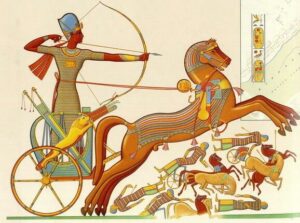Your basket is currently empty!
The image of a pharaoh, bow drawn, standing firm in a thundering chariot, is iconic. But these weren’t just any chariots. Ancient Egyptian war chariots, particularly those with curved axles, represented a pinnacle of engineering and played a crucial role in the New Kingdom’s military might. Their innovative design gave them a decisive edge on the battlefield, making them swift, stable, and deadly.
Why Curved Axles? The Genius Behind the Design

Unlike earlier, cruder chariot designs, the Egyptian curved-axle chariot was a sophisticated machine built for speed and maneuverability. The key innovation lay in the curved axle beam. Instead of a straight bar connecting the wheels, the Egyptian design featured an axle that curved forward in the center.
Here’s why this was a game-changer:
- Improved Stability: By bringing the attachment point of the body closer to the wheels, the curved axle significantly lowered the chariot’s center of gravity. This made the chariot far more stable, especially during high-speed turns or when traversing uneven terrain. A stable platform was crucial for archers and spearmen to maintain their balance and aim effectively.
- Enhanced Maneuverability: The design allowed for a wider track width while keeping the overall footprint compact. This, combined with the lower center of gravity, made the chariots incredibly agile, enabling swift changes in direction that could outflank and overwhelm enemy formations.
- Reduced Drag and Weight: While seemingly counterintuitive, the curved design, often made from light yet strong wood like elm or tamarisk, could distribute stress more efficiently, potentially allowing for a lighter overall construction without sacrificing durability. This reduction in weight contributed directly to greater speed.
Construction and Materials: A Blend of Art and Engineering
Egyptian chariots were a testament to the skill of ancient craftsmen. They weren’t just functional; they were often beautifully adorned, reflecting their importance.
Key construction elements included:
- Lightweight Wood: The frame and body were typically constructed from various types of wood, meticulously bent and joined.
- Leather and Ropes: These materials were used for suspensions, securing parts, and for the elaborate harnesses that connected the horses to the chariot.
- Bronze and Copper: Metallic elements were used for reinforcement, particularly at stress points, and for decorative purposes.
- Animal Hides: The floor of the chariot was often made of interwoven leather thongs, providing a degree of shock absorption for the occupants.
The two-wheeled design, with a small platform for a driver and an archer or spearman, was optimized for a rapid strike and retreat tactic, known as “chariot charge” or “shooting pass.”
The Chariot in Battle: A Symbol of Power and Dominance

The introduction of these advanced chariots in the New Kingdom (circa 1550-1070 BCE) revolutionized Egyptian warfare. They were primarily used as mobile firing platforms for archers, who could unleash volleys of arrows before rapidly repositioning. They also served as shock troops, breaking enemy lines with their sheer momentum and the psychological impact of their charge.
Pharaohs like Ramesses II famously utilized vast numbers of chariots in major battles, such as the Battle of Kadesh, where his chariot corps played a pivotal role against the Hittites. The chariot became a powerful symbol of royal authority and military might, frequently depicted in temple reliefs and tomb paintings.
Legacy of an Ancient Innovation
The Egyptian curved-axle chariot was more than just a weapon; it was a marvel of ancient technology that demonstrated a deep understanding of physics and engineering principles. Its design influenced subsequent chariot development in the ancient world and stands as a testament to the ingenuity of one of history’s greatest civilizations. The curved axle was a subtle yet profound modification that elevated the Egyptian chariot from a simple cart to a highly effective and feared instrument of war, solidifying the New Kingdom’s dominance for centuries.

